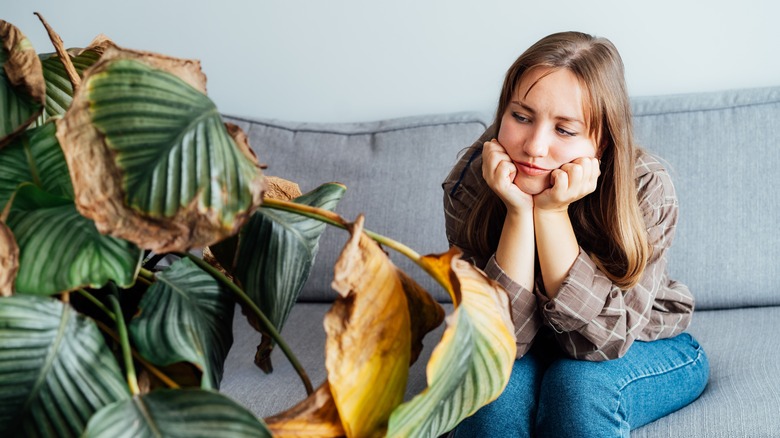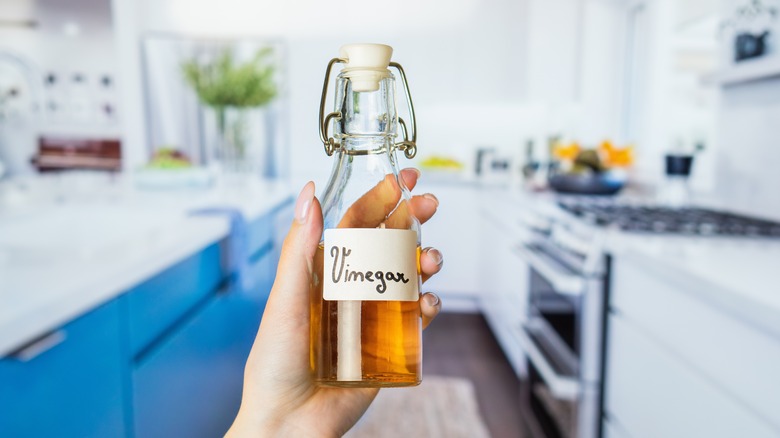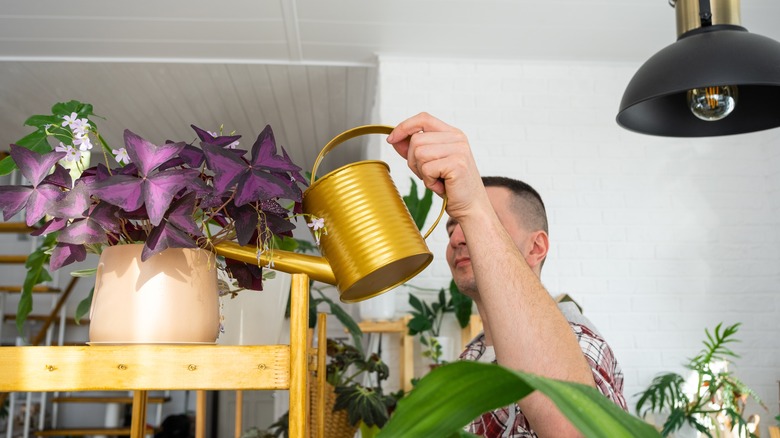This Kitchen Essential Can Save Your Houseplants From Yellowing Leaves
Wondering why your succulent leaves are turning yellow? Tired of trimming flaxen foliage from your indoor azaleas? Houseplant leaves turn yellow for a myriad of reasons. Some relatively benign issues — old age, sunburn, or watering too often or not often enough — are solved with simple location or scheduling changes or by adhering to basic indoor gardening best practices. For a specific set of yellowing leaf causes, namely high soil pH (or, as an alternative reading, not enough acidity in the soil), nutrient deficiencies, such as low iron (called chlorosis), and pest and fungal infections, kitchen vinegar diluted heavily in tap or rainwater water is an easy, accessible, and affordable rescue remedy.
Some plants, called ericaceous plants, hate lime in their soil. Lime advances the pH values in the dirt, turning it alkaline. Common ericaceous — or acid-loving — houseplants include African violets, gardenias, monsteras, peperomias, philodendrons, citrus, bleeding hearts, mountain laurel, camellias ... even rosemary and sweet potatoes. If they're planted in alkaline soil, their leaves may turn yellow. Unsure whether your go-to potting mix contains lime? Test it with vinegar! Take a tablespoon of dirt out of the planter in question, plonk it into an old cup, and pour a little vinegar on it. If the sample fizzes, it contains lime or, scientifically, calcium carbonate. This test tells you whether you need to increase the acidity — or lower the pH — of your potting mix. Vinegar, or more specifically, the acetic acid in vinegar, helps with this, too!
A soil acidifier
Kitchen vinegars contain about 4 to 6% acetic acid, giving the liquids their distinctive mouth-puckering taste. Potted peace lilies benefit from a splash of apple cider vinegar, which increases soil acidity and, bonus, helps with pest control and nutrient uptake (more on this later). Commercially produced household white vinegar has a pH of around 2.4; once diluted in water, it can make a potting mix less alkaline. Some households in the U.S., like those in central Texas and much of eastern and upper-west America, are supplied with water naturally on the alkaline side. Instead of using tap water directly on your plants, amend it with vinegar to lower the pH. If your home or building has a water softener, alkaline water might also be a problem that a splash of vinegar can address.
Some gardening experts, however, doubt vinegar's ability to lower pH levels in soil; the effect is fleeting, they say. Any acetic acid added to the soil in liquid form washes away in subsequent waterings or rainfalls, or is quickly consumed by microorganisms. Vinegar could even damage your plant's roots, advises Sharon Yiesla, Unit Educator, Horticulture, Lake/McHenry Unit for the University of Illinois Extension. It's used as a herbicide commercially, after all. A 2018 study published in the Journal of Agricultural Science found that vinegar in concentrations between 5% and 20% controlled weeds, depending on the plant species. Use fertilizers or sulfur for soil acidification instead.
Ochre hues: Other causes
Yellowing leaves can indicate an iron (Fe) deficiency in plants, especially if the change starts at the leaf's edge. A dose of vinegar can address this issue. Acetic acid enhances the bioavailability of nutrients in the dirt, and acidifying the water with vinegar replicates the effects of an iron chelate or supplement. If you're concerned about other nutritional deficiencies, use apple cider vinegar: it contains potassium, phosphorus, calcium, and magnesium. Sometimes, houseplants experience the opposite problem — an overwhelm of nutrients — following heavy-handed fertilization, causing leaves to yellow. Watering them with a water-vinegar mix can help correct this. Acetic acid is the solution to your houseplant pest problems, too. Aphids and spider mites are common causes of yellowing leaves, even indoors, and they all hate vinegar.
As with anything gardening, indoors or out, experimenting with your own plants in your own setting often yields the best results. To treat any of these issues, add anywhere between 1 teaspoon and 2 tablespoons of white household or apple cider vinegar to a gallon of water in a watering can. Water your plants immediately. If the solution is left to sit, the pH will rise. Some experts suggest doing this every time you water, while others suggest once a month. For suspected iron deficiencies, treatment once every three months is enough. To treat pests, spray the same vinegar solution on the undersides and topsides of the leaves and stems of your plants using a hand-held spray bottle.


